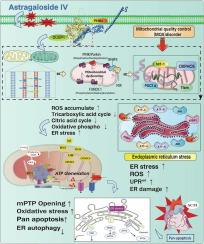当前位置:
X-MOL 学术
›
J. Adv. Res.
›
论文详情
Our official English website, www.x-mol.net, welcomes your
feedback! (Note: you will need to create a separate account there.)
Astragaloside IV alleviates septic myocardial injury through DUSP1-Prohibitin 2 mediated mitochondrial quality control and ER-autophagy
Journal of Advanced Research ( IF 11.4 ) Pub Date : 2024-11-15 , DOI: 10.1016/j.jare.2024.10.030 Junyan Wang, Xiangyi Pu, Haowen Zhuang, Zhijiang Guo, Mengyuan Wang, Huaihong Yang, Chun Li, Xing Chang
中文翻译:

黄芪甲苷 IV 通过 DUSP1-Prohibitin 2 介导的线粒体质量控制和 ER 自噬减轻脓毒性心肌损伤
脓毒性心肌病 (SCM) 是严重脓毒症患者心肌损伤的一种并发症。
本研究强调了黄芪甲苷 IV(AS) 治疗脓毒性心肌病的潜力,为开发靶向 DUSP1-PHB2 相关线粒体-ER 相互作用的心脏保护药物提供参考。
双特异性磷酸酶-1 (DUSP1)/禁止蛋白 2 心肌细胞特异性敲除小鼠 (DUSP1/PHB2CKO) /DUSP1 转基因小鼠 (DUSP1/PHB2TG) 生成 LPS 诱导的脓毒症模型。使用心脏超声、荧光染色、透射电子显微镜和蛋白质印迹法检测 AS-IV 改善心脏损伤的病理机制。用 DUSP-1/PHB2 处理心肌细胞 siRNA 后,使用 qPCR、western blotting、ELISA 和激光共聚焦显微镜测定线粒体功能和形态的变化,并进一步检查 AS-IV 的靶向治疗效果。
SCM 治疗会导致严重的线粒体功能障碍。然而,黄芪甲苷 IV (AS) 治疗使线粒体稳态和 ER 功能正常化。值得注意的是,保护作用在 DUSP1/Prohibitin 2 心肌细胞特异性敲除小鼠 (DUSP1/PHB2CKO) 中被阻断,但在 DUSP1 转基因小鼠 (DUSP1/PHB2TG) 中不受影响。
本研究强调了 AS 治疗脓毒性心肌病的潜力,为开发靶向 DUSP1-PHB2 相关线粒体-ER 相互作用的心脏保护药物提供了参考。
更新日期:2024-11-15
Journal of Advanced Research ( IF 11.4 ) Pub Date : 2024-11-15 , DOI: 10.1016/j.jare.2024.10.030 Junyan Wang, Xiangyi Pu, Haowen Zhuang, Zhijiang Guo, Mengyuan Wang, Huaihong Yang, Chun Li, Xing Chang

|
Introduction
Septic cardiomyopathy (SCM) is a complication of myocardial injury in patients with severe sepsis.Objectives
This study highlights the potential of Astragaloside IV(AS) in the treatment of septic cardiomyopathy and provides a reference for developing cardioprotective drugs targeting DUSP1-PHB2-related mitochondria-ER interaction.Methods
Dual specificity phosphatase-1 (DUSP1)/Prohibitin 2 cardiomyocyte-specific knockout mice (DUSP1/PHB2CKO) /DUSP1 transgenic mice (DUSP1/PHB2TG) were used to generate LPS-induced sepsis models. The pathological mechanism by which AS-IV improves heart injury was detected using cardiac ultrasound, fluorescence staining, transmission electron microscopy, and western blotting. After siRNA treatment of cardiomyocytes with DUSP-1/PHB2, changes in mitochondrial function and morphology were determined using qPCR, western blotting, ELISA, and laser confocal microscopy, and the targeted therapeutic effects of AS-IV were further examined.Results
SCM treatment leads to severe mitochondrial dysfunction. However, Astragaloside IV (AS) treatment normalizes mitochondrial homeostasis and ER function. Notably, the protective effect was blocked in DUSP1/Prohibitin 2 cardiomyocyte-specific knockout mice (DUSP1/PHB2CKO) but remained unaffected in DUSP1 transgenic mice (DUSP1/PHB2TG).Conclusion
This study highlights the potential of AS in the treatment of septic cardiomyopathy and provides a reference for developing cardioprotective drugs targeting DUSP1-PHB2 related mitochondria-ER interaction.中文翻译:

黄芪甲苷 IV 通过 DUSP1-Prohibitin 2 介导的线粒体质量控制和 ER 自噬减轻脓毒性心肌损伤
介绍
脓毒性心肌病 (SCM) 是严重脓毒症患者心肌损伤的一种并发症。
目标
本研究强调了黄芪甲苷 IV(AS) 治疗脓毒性心肌病的潜力,为开发靶向 DUSP1-PHB2 相关线粒体-ER 相互作用的心脏保护药物提供参考。
方法
双特异性磷酸酶-1 (DUSP1)/禁止蛋白 2 心肌细胞特异性敲除小鼠 (DUSP1/PHB2CKO) /DUSP1 转基因小鼠 (DUSP1/PHB2TG) 生成 LPS 诱导的脓毒症模型。使用心脏超声、荧光染色、透射电子显微镜和蛋白质印迹法检测 AS-IV 改善心脏损伤的病理机制。用 DUSP-1/PHB2 处理心肌细胞 siRNA 后,使用 qPCR、western blotting、ELISA 和激光共聚焦显微镜测定线粒体功能和形态的变化,并进一步检查 AS-IV 的靶向治疗效果。
结果
SCM 治疗会导致严重的线粒体功能障碍。然而,黄芪甲苷 IV (AS) 治疗使线粒体稳态和 ER 功能正常化。值得注意的是,保护作用在 DUSP1/Prohibitin 2 心肌细胞特异性敲除小鼠 (DUSP1/PHB2CKO) 中被阻断,但在 DUSP1 转基因小鼠 (DUSP1/PHB2TG) 中不受影响。
结论
本研究强调了 AS 治疗脓毒性心肌病的潜力,为开发靶向 DUSP1-PHB2 相关线粒体-ER 相互作用的心脏保护药物提供了参考。


















































 京公网安备 11010802027423号
京公网安备 11010802027423号